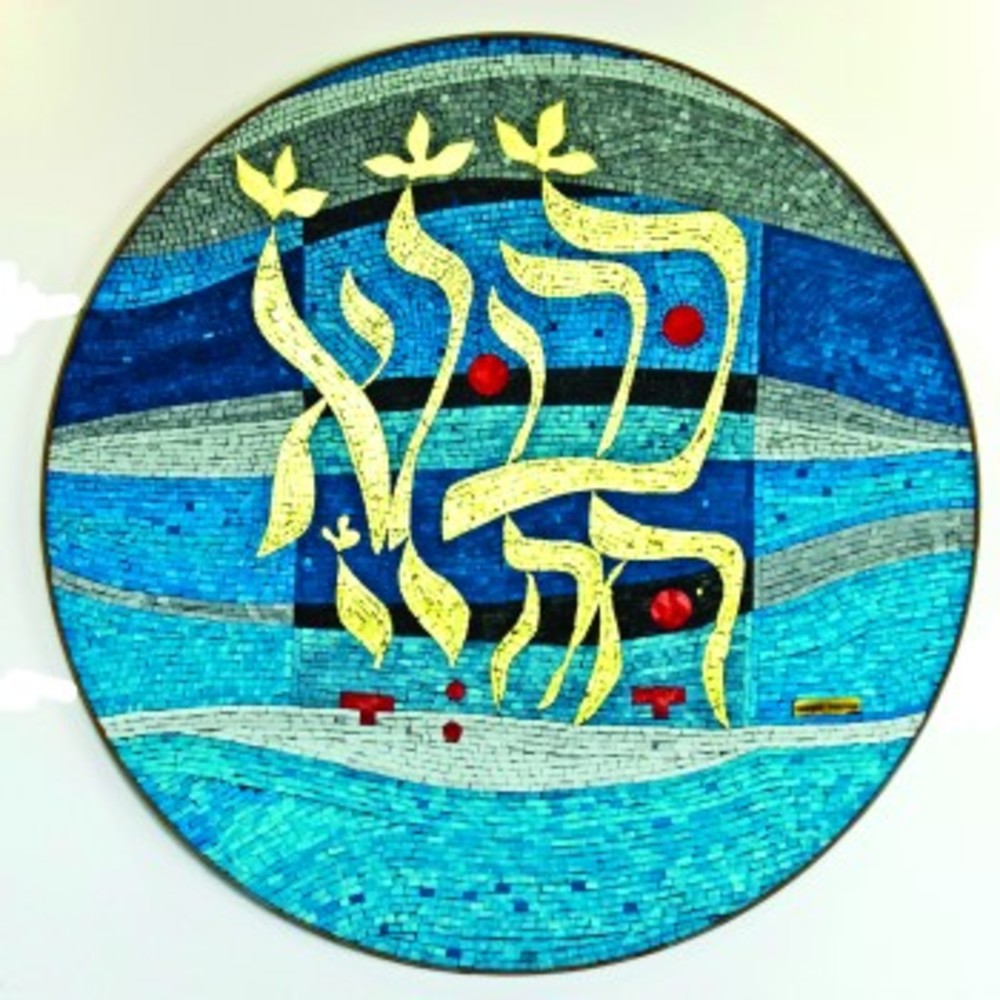Art at the Miriam reflects its roots

visitors as they enter the main door to The Miriam Hospital.
Peace, blessings and health have been important words in the life of The Miriam Hospital since its founding by a group of women in Providence as a place for Jewish doctors to practice and a home for Jewish patients. Today, The Miriam’s roots are nowhere more evident than in the artwork on its walls. Art is everywhere, much of it with a Jewish focus.
Walk into the main entrance and to the right is a showcase with a constantly changing exhibit. The latest is a display of beautiful Seder plates. To the left is a large round mosaic, “Blessed is the Lord,” the creation of Walter Feldman of Providence, who also created several paintings on display throughout the first floor of the hospital building. Feldman, a professor emeritus at Brown University, has created art in places around Providence, including in Temple Beth-El and Temple Emanu-El.
“We want to let the community know that Jewish culture is still safe and sound and honored in a significant way,” said Sandra Cheng, vice president of support services. “We want to make sure that we don’t lose the traditions.”
To that end, the walkway through the hospital from Seventh Street to Fifth Street has been named Heritage Way. A sign is forthcoming. Hospital visitors can linger over David Sharir’s group of serigraphs – called “The Seven Festivals” – depicting major Jewish holidays. They are large, interesting and eye-catching. You just have to stop, read the explanations and take them in. This collection was the beginning of grouping art to tell a story, according to Cheng. The entirety of Heritage Way will be Jewish and Jewish-related artwork. The Chapel is also in this corridor. All of the works have been donated to The Miriam. Every piece has a plaque with an explanation and the donor’s name.
There are examples of Women of Valor and Old Jerusalem. Several of both themes also appear in different places in the building.
Fred DeGregorio, Lifespan’s accounting operations director, created the beautiful color photographs of Israel. These are on display on the first floor main area and throughout the building.
Art can calm patients and their loved ones, and, in some cases, even make a patient smile. It can also “tell the world what we do,” according to Cheng. Years ago, Cheng asked Dr. Stanley Simon to help collect artwork done by physicians at the hospital. Displaying that artwork serves to humanize the physicians, Cheng felt. So there are examples of paintings and photography done by Miriam doctors throughout the hospital. Take the Dr. Stanley Simon Wall of Photography established after his death. Dr. Simon photographed animals. He assembled a collection of animal photographs that now hangs in the hallway near the elevators. “If people can smile, it loosens their mind,” says Cheng. “The animals connect with you.” And people do stop and comment.
Even the patient-care areas have been a venue to hang meaningful art. Estelle Klemer, an active Women’s Association member for many years, established the Healing Artwork Fund that is responsible for many of these paintings. When money is donated to this fund, Klemer carefully chooses the artwork and helps decide where it should hang.
One of the newest pieces of art in The Miriam collection is called “A Tribute to the Women of the Miriam,” painted and donated by Donna J. Ayala. It depicts women from the Miriam’s history. The artist, a painting student at RISD, had been doing historical research and designed the picture to interpret the diverse roles women have played in the life of The Miriam. It’s not hanging yet, according to Cheng, but plans are to hang it above the Women’s Association case.
And in the Sopkin Auditorium, the walls are adorned with colorful art and Hebrew words expressing those Miriam values: Health, Blessings and Peace. Several years ago, the wall art was beginning to show its age. Cheng asked Feldman to have a look, and he worked to restore it so conference goers could continue to enjoy its bright colors.
Even the newly refurbished Emergency Room is decorated with paintings donated by Ruth Brandt who recently passed away and was once a patient at The Miriam.
“People always think that artwork is optional,” Cheng says. “But it’s important. It’s an important component to tell the world what we do” here at The Miriam.
FRAN OSTENDORF is editor of The Jewish Voice







